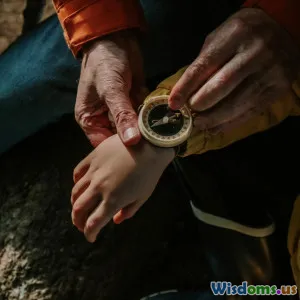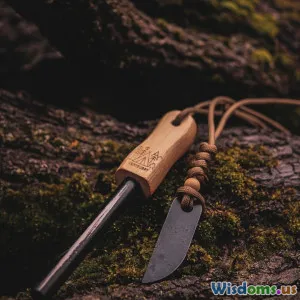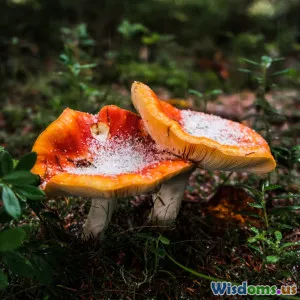
Adventure Survival Skills to Master
8 min read Master essential adventure survival skills to thrive in the wild, stay safe, and enjoy unforgettable outdoor experiences. (0 Reviews)
Adventure Survival Skills to Master
Venturing into the wild is an exhilarating experience that blends excitement with the need for preparedness. Whether you are a seasoned explorer or a novice hiker, mastering adventure survival skills is crucial. These skills not only increase your chances of thriving in unexpected situations but also empower you to respect and adapt to nature’s demands. This article will uncover fundamental survival techniques, real-world applications, and tips that every adventurer should know.
Why Survival Skills Matter
Imagine being miles away from civilization, a sudden change in weather, or an unexpected mishap leaves you stranded. Adventure survival skills are your lifelines in such scenarios. According to the National Outdoor Leadership School (NOLS), advanced survival skills can reduce the risk of peril while enhancing mental fortitude and physical endurance. But survival isn't just about hardship; it's about enjoying adventures confidently and responsibly.
Essential Adventure Survival Skills
1. Fire Crafting: The Art of Making and Managing Fire
Fire is often called the cornerstone of survival. It provides warmth, a means to cook food, purify water, and even acts as a signal for rescuers. Mastering fire crafting involves understanding several methods such as:
- Friction-based techniques: Bow drill and hand drill methods require practice but are effective without modern tools.
- Spark ignition: Using a ferro rod or flint and steel is faster and widely recommended.
- Modern tools: Waterproof matches or lighters for quick ignition.
For example, the ability to spark a fire amidst damp conditions was highlighted during the 1996 Mount Everest disaster, where climbers used fires to keep warm and survive. Always carry a reliable fire-starting kit and know how to prepare tinder from natural materials like dry bark or grasses.
2. Navigation Skills: Finding Your Way Without GPS
In the digital age, GPS devices are common, but technology can fail. Traditional navigation skills using maps and compasses remain vital. Understanding topographical maps, recognizing natural landmarks, and using the sun or stars to orient yourself can prevent becoming hopelessly lost.
For instance, during the 2011 Japan earthquake, many outdoor enthusiasts had to navigate treacherous terrain without electronic aids. Learning to read a compass can mean the difference between reaching safety or more danger.
3. Shelter Building: Creating Safe Havens
A sturdy shelter protects you from the elements, prevents hypothermia, and provides psychological comfort. Knowing how to craft shelters from natural materials or utilizing essential equipment can drastically improve survival odds.
Popular techniques include:
- Lean-to shelters: Simple structures that use branches and leaves to shield from wind and rain.
- Debris huts: Insulated shelters built with layers of leaves and twigs.
- Snow caves: Effective in cold climates for insulation.
Practicing these skills in different environments ensures flexibility when faced with nature's diversity.
4. Water Procurement and Purification
Water is a non-negotiable survival element; the human body can survive only about three days without it. Identifying sources such as streams, dew, or rain is crucial, but so is purification to avoid illness.
Methods for purification include:
- Boiling: Kills pathogens safely but requires fire and fuel.
- Chemical treatments: Water purification tablets, iodine, or chlorine solutions.
- Filtration: Portable filters remove physical and biological contaminants.
In 2014, researchers from the CDC noted that consuming untreated water in wilderness settings leads to diarrheal diseases, emphasizing water safety importance. Carry multiple purification options.
5. Food Foraging and Identification
Hunger may not set in for days, but knowing local edible plants, insects, or fishing techniques can supplement your energy needs. However, this skill demands caution to avoid poisonous species.
Books like "Edible Wild Plants: Wild Foods from Dirt to Plate" by John Kallas can guide beginners. Practical rules include avoiding unfamiliar plants and learning to recognize key toxic characteristics.
6. First Aid and Self-Care
Injuries in the wild can escalate quickly without proper care. Basic first aid skills such as treating cuts, burns, fractures, and recognizing hypothermia or heatstroke symptoms are essential.
Having a well-stocked first aid kit and knowledge—for example, the military’s Basic Survival Medicine principles—can prevent minor injuries from becoming life-threatening.
7. Situational Awareness and Mental Resilience
Perhaps the most underrated survival skill is mental preparedness. Staying calm, thinking critically, and planning steps methodically helps in managing the often chaotic nature of emergencies.
The U.S. Army Survival Manual highlights the importance of the "Survival Mindset," advocating optimism and resourcefulness as key survival elements.
Real-World Insight: A Safety Checklist for Adventurers
- Inform someone of your trip details and expected return.
- Pack a multi-tool, fire starter, compass, and water purification means.
- Wear appropriate clothing, layering for varying weather conditions.
- Learn the local environment’s specific hazards and survival tips.
- Practice skills regularly to maintain proficiency.
Conclusion
Mastering adventure survival skills transforms your outdoor endeavors from a gamble into a responsible pursuit of nature’s challenges. The ability to ignite a fire, navigate without electronics, build protective shelter, procure safe water, identify food, administer first aid, and maintain mental resilience can save your life and enrich your outdoor experiences.
Preparedness is the best companion on adventure paths. By continually educating yourself and practicing these survival techniques, the wilderness becomes not a place of fear, but one of confident exploration and discovery. Take the first step today; your next adventure awaits.
References
- National Outdoor Leadership School (NOLS): Survival Techniques
- U.S. Army Survival Manual FM 21-76
- Centers for Disease Control and Prevention (CDC): Wilderness Medicine
- John Kallas – Edible Wild Plants Guide
- Personal accounts from Everest expeditions and disaster reports
Whether you're backpacking in dense forests or exploring mountain trails, developing these survival skills will equip you for the unpredictable beauty of the wild.
Rate the Post
User Reviews
Popular Posts



















